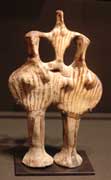.

Phi (upper case Φ, lower case φ or φ) is the 21st letter of the Greek alphabet. It is pronounced fee by modern Greeks, or fie (depending on context and, often, personal inclination). In the system of Greek numerals it has a value of 500.
The lower-case letter φ (or often its variant, φ) is used as a symbol for:
- The golden ratio 1.618... in mathematics, art, and architecture.
- Euler's totient function in number theory. Also called Euler's phi function, φ(n)
- The argument of a complex number in mathematics.
- The value of a plane angle in physics and mathematics.
- The work function in electronics.
- The phase of a wave in signal processing.
- In spherical coordinates phi is usually used to represent the angle to the z axis.
- In engineering, the diameter symbol is often referred to as "phi". This symbol is used to indicate the diameter of a circular section, for example 14 means the diameter of the circle is 14 units.
- In structural engineering, Φ is notation for a strength (or resistance) reduction factor, used to account for statistical variabilities in materials and construction methods.
- Any function in mathematics.
The upper-case letter Φ is used as a symbol for:
- The magnetic flux in physics.
- The Cumulative Normal Distribution function in statistics.
See also phi phenomenon.
Music

Henri Christiné (1867 - 1941). Phi-Phi.
| Ancient Greece
Science, Technology , Medicine , Warfare, , Biographies , Life , Cities/Places/Maps , Arts , Literature , Philosophy ,Olympics, Mythology , History , Images Medieval Greece / Byzantine Empire Science, Technology, Arts, , Warfare , Literature, Biographies, Icons, History Modern Greece Cities, Islands, Regions, Fauna/Flora ,Biographies , History , Warfare, Science/Technology, Literature, Music , Arts , Film/Actors , Sport , Fashion --- |
Retrieved from "http://en.wikipedia.org/"
All text is available under the terms of the GNU Free Documentation License

